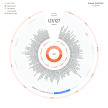Faster, stronger: on India and its supercomputer use
Faster, stronger: on India and its supercomputer use
Later this year, India will have a new ‘supercomputer’ or, more correctly, an upgraded ‘high performance computing (HPC)’ system that will arguably be its fastest. This system is to be made and installed by the French corporation, Atos — an information technology service and consulting company. The Narendra Modi government signed a deal in December 2018 with France to procure high-performance computers worth ₹4,500 crore by 2025. These HPC systems will run at two institutions, the Indian Institute of Tropical Meteorology, Pune, and the National Centre for Medium Range Weather Forecasting, Noida, that currently host two of India’s most powerful such machines, Mihir and Pratyush. Like their predecessors, the Atos machines will be used primarily to run sophisticated weather models that, for some years now, are being used to prepare a range of forecasts, from long-term monsoon to fortnightly as well as daily weather changes. Extremely powerful machines are needed for this purpose as accurate forecasts are premised on being able to simulate the state of the atmosphere and oceans. ‘Supercomputers’ is a buzzword and term that is in constant flux. Supercomputers of two decades ago are today’s student laptops and gaming consoles.
While many challenging research questions, apart from weather modelling, are extremely dependent on computing — protein biology, aerospace-modelling applications, and now AI-linked applications —the possession of HPCs is also used as a medallion by countries wanting to signify their technological prowess. The Top500 project has for over two decades maintained a list of the top 500 most powerful HPC machines and this is updated twice a year, with countries prominently advertising the presence of their systems if they make it to the list. Currently, a machine housed at Pune’s Centre for Development of Advanced Computing (CDAC) is the only Indian machine in the top 100 with a top speed of 13 petaflops. Floating point operations per second (FLOPS) are an indicator of computer processing abilities and 1 petaflop is a 1,000 trillion flops. The to-be installed French machines are expected to be 18 petaflops and India already has a handful of machines at multiple research institutions in the petaflop range. The possession of powerful supercomputers is certainly a reassurance that Indian scientists, wanting to solve intractable problems, can always tap these behemoths, but whether the use of these machines has translated into significant breakthroughs in fundamental science or engineering commercial products is another matter. Much like India has improved its short-term weather forecasts and made cyclone forecasts more accurate on the back of such machines, there should be greater accounting of their worth in other fields, rather than be content with epithets of speed and power.
Summary of the Editorial
1. Later this year, India will install an upgraded 'high performance computing' (HPC) system, arguably the country's fastest supercomputer.
2. The system is being manufactured by Atos, a French IT service and consulting company.
3. The Indian government signed a deal with France in 2018 to procure high-performance computers by 2025 worth ₹4,500 crore.
4. The supercomputers will be located at the Indian Institute of Tropical Meteorology in Pune,
and the National Centre for Medium Range Weather Forecasting in Noida, which currently host India's most powerful machines, Mihir and Pratyush.
5. Like their predecessors, the Atos machines will primarily be used for sophisticated weather models.
6. Supercomputers are needed for accurate weather forecasting, which requires the simulation of atmospheric and oceanic conditions.
7. Apart from weather modeling, several research areas, including protein biology, aerospace- modelling applications, and AI-linked applications, are heavily dependent on computing.
8. The possession of HPCs is often used as a mark of technological prowess by nations.
9. The Top500 project maintains a list of the top 500 most powerful HPC machines, updated twice a year.
10. Currently, a machine at Pune’s Centre for Development of Advanced Computing (CDAC) is the only Indian system in the top 100 with a top speed of 13 petaflops.
11. The French machines to be installed are expected to reach 18 petaflops.
12. India has multiple research institutions with machines in the petaflop range.
13. The utilization of powerful supercomputers is significant for Indian scientists working on complex problems.
14. However, the extent to which these supercomputers have contributed to significant scientific breakthroughs or commercial products is debatable.
15. There should be more evaluation of their worth in various fields, instead of only considering the attributes of speed and power.







Comments
There are no comments for this story
Be the first to respond and start the conversation.